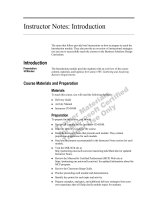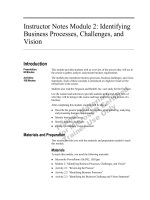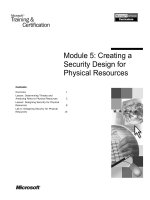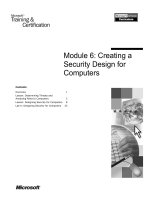Tài liệu Instructor Notes Module 3: Using a Conceptual Design for Data Requirements pdf
Bạn đang xem bản rút gọn của tài liệu. Xem và tải ngay bản đầy đủ của tài liệu tại đây (102.88 KB, 4 trang )
Instructor Notes Module 3: Using a
Conceptual Design for Data
Requirements
Introduction
This module provides students with a systematic method for beginning the
design process by gathering information and then turning that information into
use cases and data requirements. Both functional and nonfunctional data
requirements are discussed, and students will learn to validate their work by
tracing the requirements back to the original business needs.
After completing this module, students will be able to:
!
Describe the information investigation process.
!
Determine functional data requirements from use cases.
!
Identify nonfunctional requirements that will affect a solution’s design.
Materials and Preparation
This section provides you with the materials and preparation needed to teach
this module.
Materials
To teach this module, you will need the following materials:
!
Microsoft
®
PowerPoint
®
file P03_1609a.ppt
!
Module 3, “Using a Conceptual Design for Data Requirements”
!
Activity 3.1, “Identifying Data-Related Use Cases and Data Requirements”
!
Activity 3.2, “Relating Data Requirements to Conceptual Design”
Preparation
To prepare for this module, you should:
!
Read all materials for this module.
!
Complete the activities.
!
Refer to Course 1585, Gathering and Analyzing Business Requirements, for
further information on gathering business requirements.
Presentation:
55 Minutes
Activities:
30 Minutes
2 Instructor Notes Module 3: Using a Conceptual Design for Data Requirements
Activities
Activity 3.1: Identifying Data-Related Use Cases and Data
Requirements
In this activity, students will determine data requirements, hidden data
requirements, and nonfunctional data requirements for a set of given use cases.
This activity consists of three exercises that require the student to fill in a grid.
Be sure to keep the class aware of the passage of time; otherwise, some students
might spend so much time on one or two exercises that they will not be able to
complete the entire activity. Also try to allow some time for discussion after the
activity.
After completing this activity, students will be able to:
!
Determine data requirements from use cases.
!
Determine what nonfunctional requirements will affect the solution’s
conceptual design.
!
To prepare for the activity
1. Review the case study.
2. Complete all three exercises. Note that the answers given on the Student CD
are at a fairly high level. You might want to further clarify the data
requirements to prepare for possible answers from the students.
Activity 3.2: Relating Data Requirements to Conceptual
Design
In this activity, students will participate in an instructor-led discussion about
conceptual design and data design.
Ideally, this activity should be a fairly short class discussion. Keep the
discussion focused, but be sensitive to the opinions expressed. They might
reveal gaps in students’ understanding of the material you have just completed.
Be sure the class understands the importance of validating data requirements.
After completing this activity, students will be able to:
• Discuss use cases, data requirements, and requirements validation as they
relate to conceptual design for data systems.
!
To prepare for the activity
• Review the activity and anticipate possible responses from the students.
Instructor Notes Module 3: Using a Conceptual Design for Data Requirements 3
Module Strategy
Use the following strategy to present this module:
!
Investigation Process
This section of the module provides an overview of the investigation
process and how it forms the foundation for the development of data
requirements. The actual investigation process is thoroughly covered in
Course 1585: Gathering and Analyzing Business Requirements. If students
in your class have already taken that course, this section will be a review for
them. For students who have not taken Course 1585, this material might
contain new concepts.
Be sensitive to the varying needs of your students as you teach this section.
It is important that, by the end of this section, the entire class understand the
basics of the requirements gathering process, especially the transformation
of gathered information into use cases.
!
Data Requirements
In this section, the work of defining data requirements begins. The use cases
from the previous section form the basis for determining data requirements,
and students should be encouraged to discover not only obvious
requirements, but also requirements that might be difficult to identify.
Many students with database backgrounds will want to think and work in
the physical data model. Remind them that, at this point, the work is still in
the conceptual phase.
THIS PAGE INTENTIONALLY LEFT BLANK









